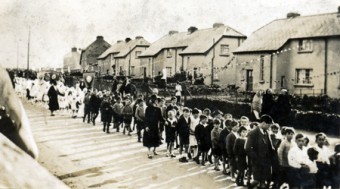Search Results for 'Carnegie Trust'
2 results found.
The May procession

The month of May is named for and dedicated to Mary, the Blessed Virgin. Many people like to honour the Virgin during that month by putting up a May altar in their house, usually on a small table or sideboard covered with a white cloth. In the place of honour is a Marian picture or statue and it is decorated with May flowers. In some parishes they have a ceremony where they crown an image of Mary with paste jewels, and in others, they hold a May procession in which those taking part walk bareheaded (weather permitting), in decent costume and with reverent mien. Clergy and laity, men and women, are separated. The cross is usually carried at the head, and sometimes banners embroidered with sacred pictures. These often represent sodalities but should never be of military or triangular in shape.
A May procession in the Claddagh, c1935

This photograph was originally taken from the top of the high wall which fronted the town dump in the area of the Claddagh still known as ‘The Swamp’ in 1931. In the early years of the 20th century Galway’s Parliamentary Representative Stephen Gwynn prompted the Government to award a grant of £450 for the reclamation of this marshy ground between the Claddagh and the seashore, which was prone to flooding, and as a result a half-mile racing track in the shape of a rectangle with rounded corners was built around the perimeter of the area. It cannot have been very successful, because some time afterwards the area became the site for the city dump. In 1931 the Carnegie Trust presented the city with a grant of £500 to help develop part of the site into a number of playing pitches. This development was a gradual process and eventually, in the early fifties, the whole area was converted into a municipal park devoted entirely to sporting activities. The high wall was largely knocked and reduced to its present height. It took a while to completely clear the ground... many who played matches there at the time remember taking lumps of glass or tin out of the surface of the playing pitch and leaving them on the side wall.

